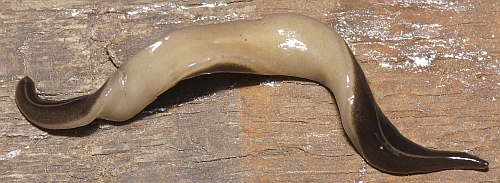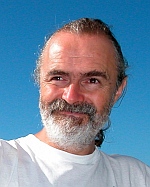Today, we are pleased to publish “The invasive New Guinea flatworm Platydemus manokwari in France, the first record for Europe: time for action is now”, and we invited Pr. Jean-Lou Justine, first author on the paper, to comment on his research.

Jean-Lou Justine is a Professor at Muséum National d’Histoire Naturelle in Paris, one of the most important natural history museums in the world, and Deputy Director of the very recently created (2014) Institute of Systematics, Evolution, and Biodiversity. He is mainly a parasitologist, with a focus on phylogeny and systematics of two groups of helminths, the flatworms (especially the monogeneans) and the nematodes, and he has published more than 200 scientific papers. In the course of his career, he was a University teacher and researcher in Senegal (1978-1985) and a researcher in Institut de Recherche pour le Développement in New Caledonia from (2003-2009) where he focused his research on parasite biodiversity of coral reef fish.
PJ: Tell us a bit about the research you publish today, and why it is interesting.
JLJ: I won’t tell why it is interesting to me – any researcher finds his own research extremely interesting. What should be emphasized is that this research might be understood and appreciated by the general public. It is frustrating, when you work on some very specialized research, that you cannot discuss this research with more than, say, a dozen persons in the whole world. I remember once that one of my presentations in a congress was featured by a local newspaper as an example in which they could not understand a single word of the title! In contrast, a research on Invasive Alien Species can be readily understood by any teenager with some taste for biology. That does not mean, however, that it is so simple to perform.
PJ: What challenges did you face while doing this research?
JLJ: Platydemus manokwari is only one among half a dozen species found in France in the course of our research in the last twelve months. It all began in March 2013 with an amateur entomologist, Pierre Gros who posted on an internet forum the photograph of a bizarre worm found in his garden. The photograph was forwarded to me by chance and I immediately reacted: that was a large land planarian, and such animals are supposed to live only in the Southern hemisphere. I contacted Pierre and we treated his first specimen with the utmost respect, as if it was the only one of its kind. The information about this strange worm then went viral among French amateur naturalists and I received dozens of emails, often reporting other land planarians in various parts of France. What was striking is that there was nothing in the scientific literature! I still cannot understand why the presence of animals 40 centimeters in length, such as Bipalium kewense, never raised the interest of French scientists. In May 2013 I established a small website for informing the public and gathering information – today it has received more than 30,000 visits. Jessica Thévenot from the Service du Patrimoine Naturel (the French national office for biodiversity) helped with maps. The challenge was then to respond to daily numerous emails and telephone calls, even on weekends.

.
PJ: How did you identify the New Guinea flatworm Platydemus manokwari?
JLJ: That was easy, because I had the help of an outstanding specialist of land planarians, Leigh Winsor. I sent a few photographs to him and he immediately recognized the species – indeed, it was the subject of his Master thesis in 1990, and he has now the animal in his own garden in Townsville, Australia. Delphine Gey then sequenced the COI gene of two specimens, which was found to be close to the single sequence of P. manokwari deposited in GenBank. This is where we were lucky, because at least we had one sequence of the species deposited in GenBank. Furthermore, we were confident in the morphological identification of the GenBank specimen, because it was Leigh himself who collected it. However, this is not the case for many land planarians which we also found in France: in those cases we might have sequences, but we cannot compare them to any reference material. We plan to collect reference material in the places of origin of these invasive species.
PJ: What are the effects of the introduction of this flatworm in Europe?
JLJ: The whole purpose of this paper is to never see the effect of the introduction of this flatworm in Europe, because we expect it will be stopped right now, before it spreads! We really hope that it is only in the hothouse in Caen now. However, when the photographs of Platydemus manokwari are advertised in France and Europe, we might receive reports from other places. I really hope that will not happen.
Wherever it has been introduced, Platydemus manokwari has preyed upon snails, including endemic and endangered species. In our quick predation tests, one specimen immediately preyed upon a European species of snail.
PJ: Is there a way to control the spread of this flatworm?
JLJ: Yes, if measures are taken immediately and efficiently – hence the title of our paper “time for action is now”. However, I am a scientist, not a law maker. It is encouraging that at least one French senator and one Belgian congressman already issued official documents about the spreading of land planarians in their countries. Whether the authorities will do something or not completely escapes my control.
PJ: What kinds of lessons do you hope the public takes away from your research?
JLJ: I hope that the public will understand that they have a major, active role to play in science – what is called “citizen science”. We received hundreds of messages or phone calls from people who, obviously, never thought before that their contribution could be useful for science and research. I could never have visited hundreds of individual gardens in the whole country to check for the presence of land planarians.
PJ: How did you first hear about PeerJ, and what persuaded you to submit to us?
JLJ: As the Editor of an open-access journal, I like to keep informed about open-access and publishing in general, so the information about the launching of PeerJ one year ago certainly did not escape my attention.
The beautiful layout of the PeerJ website, the fact that alternate metrics are featured and that readers can add comments are certainly the best reasons why we published in PeerJ. We then discovered that PeerJ is extremely fast and professional.
PJ: How would you describe your overall experience with us?
JLJ: An excellent experience with committed professionals in scientific publishing. To be in direct contact with Peter Binfield himself, for the preparation of the press release, was rewarding.
PJ: What do you think about our “Pay once, Publish for life” publishing plans?
JLJ: Too good to be true!
PJ: Anything else you would like to highlight?
JLJ: I particularly appreciated the fact that PeerJ accepted to publish, as supplemental information, a complete French translation of the paper. This will make it much easier for the general public in France to read the article.
I have another paper now accepted in PeerJ, on a different theme, systematics of fish parasites. With the new (2012) rules of Zoological Nomenclature that allow publication of new taxa in online journals, I expect that PeerJ will become an important journal in the field of systematics and biodiversity.
PJ: Many thanks for your time!
Experience the PeerJ process for yourself, and take advantage of our free publication offer (when you also submit a preprint) through the last day of March.

